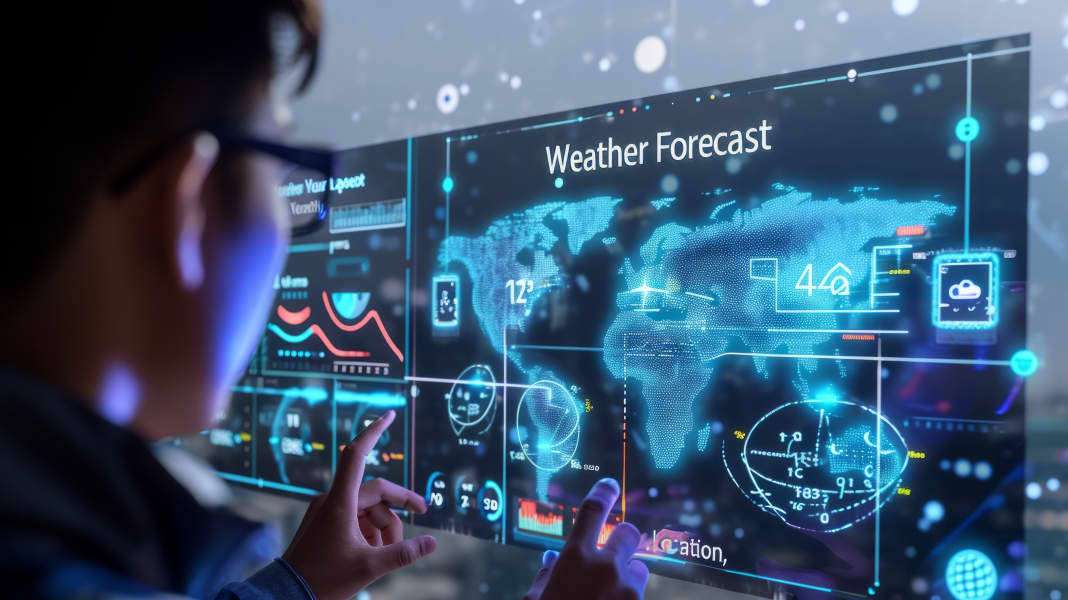
Mr Wache, how will AI influence the weather forecast of tomorrow?
This is a very exciting field. Google's GraphCast is currently the most promising approach to integrating AI into weather forecasting. It uses global weather data from the last 40 years, i.e. the forecast data and the situations that have actually occurred, to train the AI. With this so-called re-analysis data, the model has a good basis for learning how highs and lows shift, for example. The physical laws of the earth and statistical values are then added to this. For example, the AI model knows that the hurricane has moved in direction X in a certain weather situation. This huge amount of data and the corresponding pool of knowledge is then used to make forward calculations.
Does this require super-computers that spend hours working on a forecast?
On the contrary! While the huge computers, which are also located in the basement of the German Weather Service, take several hours to calculate a numerical weather model, the AI model spits out the results after just a few minutes and even requires far less computing power. In tests, the results of the European Centre for Medium-Range Weather Forecasts (ECMWF) were compared with those of the AI model. In an incredible 90 per cent of cases, the AI was more accurate in terms of measured values such as temperature, wind speed and air pressure. This can confidently be described as a game changer in wind and weather forecasting.
Will the AI approach soon make the profession of meteorologist superfluous?
I actually don't think so, because AI also has its weaknesses. Since it is logically only trained with historical weather data, it cannot decisively take into account the climate changes that have already been set in motion. A storm with record values measured in Corsica, for example, could be much more severe in the near future, as the sea will continue to warm and this will also generate more energy in the atmosphere. Weather events could therefore be underestimated or even misinterpreted. Experts will still be needed to interpret weather patterns and refine forecasts accordingly. AI can therefore only be a help - albeit a very good one.
Has AI reached the pinnacle in terms of the accuracy and reliability of weather forecasts?
I don't think AI is the last word in wisdom. It's only a matter of time before something new comes along. Fifteen years ago, I used to hang weather charts all over the office. And when a sailor called in with his position, I printed out the weather maps for the region and used a triangle, compass and pencil to determine where the sailor would be at his average speed and what he could expect. Today, with the latest technology, I can conjure up a weather routing from my pocket between two trade fair presentations if I get an urgent enquiry. Thanks to AI, this will be much faster and more precise in the future. But who knows what will come next?
What is your forecast for the year 2024?
2023 was a year of extremes: droughts, torrential rainfall, floods of the century and devastating storms. This year is expected to be just as extreme, perhaps even worse. The global warming train is already in full swing and the famous 1.5 degree slowdown manoeuvre of the Paris Climate Agreement is unfortunately unlikely to be realised. This means that we have to learn to deal with global warming and adapt to extreme weather conditions. Of course, this doesn't always happen across the board, but rather selectively. So it may be that we have a nice and relaxed summer in Hamburg and Kiel and people wonder where the extreme weather is. But if it's not on our doorstep, it's certainly happening somewhere else - and the impacts are getting closer.
More articles on wind and weather
- SEAMANSHIP: This wind pressure is generated on yachts during storms
- ORKANTIEF CIARÁN: The weather bomb has exploded
- CENTURY FLOOD: Over 200 total losses - "Schilksee resembles a battlefield"
- WEBINAR ON 26.02. AND 04.03.2024: Trip planning according to the weather - how to avoid strong winds, calm and other unpleasant surprises. Register now!

